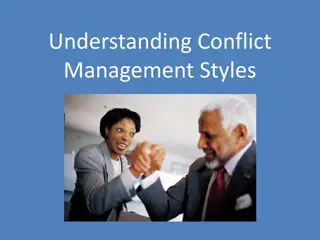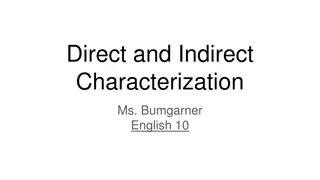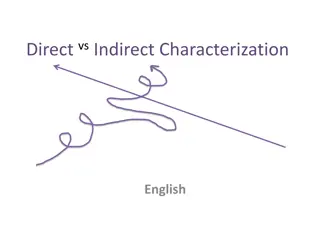Understanding Conflict and Characterization in Storytelling
Learn about the importance of conflict in storytelling, both internal and external, and how authors develop characters through direct and indirect characterization. Explore examples and practice matching character traits with their descriptive actions in this engaging study session.
Download Presentation

Please find below an Image/Link to download the presentation.
The content on the website is provided AS IS for your information and personal use only. It may not be sold, licensed, or shared on other websites without obtaining consent from the author. Download presentation by click this link. If you encounter any issues during the download, it is possible that the publisher has removed the file from their server.
E N D
Presentation Transcript
8/26: Bell Work Bell Work: Write a sentence using the word mawkish. Notebooks needed today!
8/26 Conflict and Characterization We need conflict in a story! External Conflict: A character struggles against an outside force, such as another character, society, or nature. Internal Conflict: The struggle between opposing needs, desires, and emotions taking place within a person
Examples of Conflict He slowly made his way across the barren and merciless desert. Annabelle hit her sister over the head at dinner because Suzy grabbed the last piece of fried chicken. She struggled with her conscience; she wanted to keep the twenty dollars the cashier gave her accidentally,
What is characterization? The way an author develops characters in a story Direct Characterization: the author directly tells us what the character is about. Indirect Characterization: hints and clues are given about a character through their words and actions.
Example of Direct Characterization Example: The patient boy and quiet girl were both at the game. The author is telling us that the boy is patient and the girl is kind.
Indirect Characterization Example: Mrs. Louthain glared at her class in the morning. Indirect characterization are the hints and clues that you glean from the character through behavior, actions, and how other characters respond and react.
Indirect or Direct? Connor was feeling depressed. I love meeting new people! Charley exclaimed. Jackson smiled and waved to his classmates. Jessica s outlook on life is always cheerful.
In your notebook, match the indirect description and traits of the characters. HELPFUL NERVOUS SAD FRUSTRATED DERRICK OFFERED TO CARRY HIS NEIGHBOR S GROCERIES INTO HER HOUSE THE SMALL CHILD S FACE WAS COVERED WITH TEARS AS HE SOBBED ENDLESSLY. AS KAREN SAT IN THE WAITING ROOM, SHE BIT HER NAILS AND WIGGLED HER LEG UNCONTROLLABLY. NANCY TRIED OVER AND OVER TO SOLVE THE MATH PROBLEM, BUT SHE SUDDENLY CRUMPLED UP THE WORKSHEET AND THREW IT IN THE TRASHCAN.
Assignment First Page: Decide whether conflict in internal or external. Second Page: You will read each descriptive sentence in the left column. Choose one character trait that the description reveals about the character. Then, identify which method was used to reveal character traits! Third Page: Periods 1 and 6 will complete the additional page on character inferences.
Reviewing Conflict 1. Todd is trying to quit cheating. a. Man vs. Man Himself b. Man vs. Nature c. Man vs. 2. Mr. Smith challenged the fairness of the law. a. Man vs. Nature Himself 3. Charles had to cross the Rocky Mountains alone. Man b. Man vs. Society c. Man vs. a. Man vs. Nature b. Man vs. Society c. Man vs.
Wrapping it up! If you did not finish your worksheet, it is homework! Have a great day!























